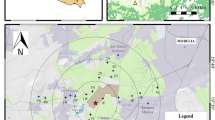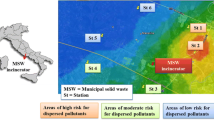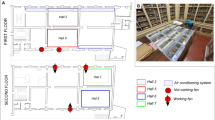Abstract
The study was focused on understanding the mercury contamination caused by a cement plant. Active and passive biomonitoring with epiphytic lichens was combined with other instrumental measurements of mercury emissions, mercury concentrations in raw materials, elemental mercury concentrations in air, quantities of dust deposits, temperatures, precipitation and other measurements from the cement plant’s regular monitoring programme. Active biomonitoring with transplanted lichens Pseudevernia furfuracea (L.) Zopf was performed at seven of the most representative sites around the cement plant and one distant reference site for periods of 3, 6 and 12 months. In situ lichens of different species were collected at the beginning of the monitoring period at the same sites. Mercury speciation of the plant exhaust gas showed that the main form of emitted mercury is reactive gaseous mercury Hg2 + , which is specific for cement plants. Elemental mercury in air was measured in different meteorological conditions using a portable mercury detector. Concentrations in air were relatively low (on average below 10 ng m − 3). In situ lichens showed Hg concentrations comparable to lichens taken from the background area for transplantation, indicating that the local pollution is not severe. Transplanted lichens showed an increase of mercury, especially at one site near the cement plant. A correlation between precipitation and Hg uptake was not found probably due to a rather uniform rainfall in individual periods. Dust deposits did not influence Hg uptake significantly. Lichens vitality was affected over longer biomonitoring periods, probably due to some elements in dust particles, their alkalinity and the influence of other emissions. Mercury uptake measured in vital transplanted lichens was in a good correlation with the working hours (i.e. emitted Hg quantity) of the kiln. The study showed that selected lichens could be used to detect low to moderate Hg emissions from a cement plant and that the biomonitoring procedure could be further standardized and used as part of an environmental monitoring programme.
Similar content being viewed by others
References
Adamo, P., Giordano, S., Vingiani, S., Castaldo Cobianchi, R., & Violante, P. (2003). Trace element accumulation by moss and lichen exposed in bags in the city of Naples (Italy). Environmental Pollution, 122(1), 91–103.
AMAP/UNEP. (2008). Technical background report to the global atmospheric mercury assessment (pp. 164). Oslo: AMAP, UNEP Chemicals.
Armstrong, R. A. (1990). The influence of calcium and magnesium on the growth of the lichens Parmelia saxatilis and Xanthoria parietina on slate substrates. Environmental and Experimental Botany, 30(1), 51–57.
Balarama, M. V., Krishna, D., Karunasagar, D., & Arunachalam, J. (2004). Sorption characteristics of inorganic, methyl and elemental mercury of lichens and mosses: Implication of biogeochmical cycling of mercury. Journal of Atmospheric Chemistry, 49(1–3), 317–328.
Bargagli, R. (1998). Trace elements in terrestrial plants. An ecophysiological approach to biomonitoring and biorecovery. Berlin: Springer.
Bargagli, R., Cateni, D., Nelli, L., Olmastroni, S., & Zagarese, B. (1997). Environmental impact of trace element emissions from geothermal power plants. Archives of Environmental Contamination and Toxicology, 33(2), 172–181.
Bari, A., Rosso, A., Minciardi, M. R., Troiani, F., & Piervittori, R. (2001). Analysis of heavy metals in atmospheric particulates in relation to their bioaccumulation in explanted Pseudovernia furfuracea thalli. Environmental Monitoring and Assessment, 69(3), 205–220.
Bergamaschi, L., Rizzio, E., Giaveri, G., Loppi, S., & Gallorini, M. (2007). Comparison between the accumulation capacity of four lichen species transplanted to a urban site. Environmental Pollution, 148, 468–476.
Bhatty J. I. (1995). Role of minor elements in cement manufacture and use. Research and Development Bulletin RD109T: Portland Cement Association.
Branquinho, C., Gaio-Oliveira, G., Augusto, S., Pinho, P., Maguas, C., & Correia, O. (2008). Biomonitoring spatial and temporal impact of atmospheric dust from a cement industry. Environmental Pollution, 151(2), 292–299.
Calasans, C., & Malm, O. (1997). Elemental mercury contamination survey in a chlor-alkali plant by the use of transplanted Spanish moss, Tillandsia usneoides (L.). Science of the Total Environment, 208(3), 165–177.
Carpi, A., Weinstein, L. H., & Ditz, D. W. (1994). Bioaccumulation of mercury by Sphagnum moss near a municipal solid waste incinerator. Air Waste, 44(5), 669–672.
Conti, M. E., & Ceccheti, G. (2001). Biological monitoring: Lichens as bioindicators of air pollution assessment – a review. Environmental Pollution, 114(3), 471–492.
Councile Directive 2000/76/EC on the incineration of waste.
Fernández, J. A., Aboal, J. R., & Carballeira, A. (2000). Use of native and transplanted mosses as complementary techniques for biomonitoring mercury around an industrial facility. Science of the Total Environment, 256(2–3), 151–161.
Fernández, J. A., Aboal, J. R., & Carballeira, A. (2004). Identification of pollution sources by means of moss bags. Ecotoxicology and Environmental Safety, 59(1), 76–83.
Fukuzaki, N., Tamura, R., Hiranom, Y., & Mizushima, Y. (1986). Mercury emission from a cement factory and its influence on the environment. Atmospheric Environment, 20(12), 2291–2299.
Garty, J. (1993). Lichens as biomonitors for heavy metal pollution. In B. Markert (Ed.), Plants as biomonitors: Indicators for heavy metals in the terrestrial environment (pp. 193–263). Weinheim: VCH.
Garty, J., Karary, Y., & Harel, J. (1993). The impact of air pollution on the integrity of cell membranes and chlorophyll in the lichen Ramalina duriaei (De Not.) Bagl. transplanted to industrial sites in Israel. Archives of Environmental Contamination and Toxicology, 24(4), 455–460.
Grönlund, R., Edner, H., Svanberg, S., Kotnik, J., & Horvat, M. (2005). Mercury emissions from the Idria mercury mine measured by differential absorption lidar techniques and a point monitoring spectrometer. Atmospheric Environment, 39(22), 4067–4074.
Hawksworth, D., & Rose, F. (1976). Lichens as air pollution monitors. London: Edward Arnold.
Hines, M. E., Horvat, M., Faganeli, J. (2000). Mercury biogeochemistry in the Idrija river, Slovenia from above the mine into the Gulf Trieste. Environtal Research, 83(2), 129–139. sec A.
Horvat, M., Jeran, Z., Špirič, Z., Jaćimović, R., & Miklavčič, V. (2000). Mercury and other elements in lichens near the INA Naftaplin gas treatment plant, Molve, Croatia. Journal of Environmental Monitoring, 2(2), 139–144.
Horvat, M., Jereb, V., Fajon, V., Logar, M., Kotnik, J., Faganeli, J., et al. (2002). Mercury distribution in water, sediment and soil in the Idrijca and Soča river systems. Geochemistry: Exploration, Environment, Analysis, 2(3), 287–296.
Horvat, M., Kontić, B., Kotnik, J., Ogrinc, N., Jereb, V., Logar, M., et al. (2003). Remediation of mercury polluted sites due to mining activities. Critical Reviews in Analytical Chemistry, 33(4), 291–296.
Horvat, M., Lupšina, V., & Pihlar, B. (1991). Determination of total mercury in coal fly ash by gold amalgamation cols vapour atomic absorption spectrometry. Analytica Chimica Acta, 243, 71–79.
Horvat, M., Zvonarič, T., & Stegnar, P. (1986). Optimization of a wet digestion method for the determination of mercury in blood by cold vapour absorption spectrometry (CV AAS). Vestnik Slovenskega Kemijskga Društva, 33(4), 475–486.
Ikigura, J. R., & Akagi, H. (2002). Lichens as a good bioindicator of air pollution by mercury in small-scale gold mining areas, Tanzania. Bulletin on Environtal Contamination Toxicology, 68(5), 699–704.
Jalkanen, L., Mäkinen, A., Häsänen, E., & Juanoja, J. (2000). The effect of large anthropogenic particulate emissions on atmospheric aerosols, deposition and bioindicators in the eastern Gulf of Finland region. Science of the Total Environment, 262(1–2), 123–136.
Jeran, Z., Byrne, A. R. , & Batič, F. (1995). Transplanted epiphytic lichens as biomonitors of air-contamination by natural radionuclides around the Žirovski vrh uranium mine, Slovenia. Lichenologist, 27(5), 375–385.
Jeran, Z., Jaćimović, R., Batič, F., & Mavsar, R. (2002). Lichens as integrated air pollution monitors. Environmental Pollution, 120(1), 107–113.
Jeran, Z., Jaćimović, R., Batič, F., Smodiš, B., & Wolterbeek, H. Th. (1996). Atmospheric heavy metal pollution in Slovenia derived from results for epiphytic lichens. Fresenius. Journal of Analytical Chemistry, 354(5–6), 681–687.
Johansen, V. C., & Hawkins, G. J. (2003). Mercury speciation in cement kilns: A literature review. PCA R&D Serial No. 2567, Portland Cement Association.
Košuta, M., & Bizjak, M. (2000). Air quality in the surrounding of Salonit Anhovo. In Air protection in Slovenia, 15–17 November, ZTI, Ljubljana (pp. 111–119). in Slovenian.
Kotnik, J., & Horvat, M. (2000). Izhodišča za izdelavo analize onesnaženosti z živim srebrom in predlog ukrepov na podlagi direktiv Evropske Unije: IJS-DP-8290. Ljubljana: Jožef Stefan Institute. In Slovenian.
Ljubič Mlakar, T., Horvat, M., Kotnik, J., Jeran, Z., Vuk, T., Mrak, T., et al. (2006). Mercury in the system of cement clinker production and emissions control. In 8th International conference on mercury as a global pollutant, Madison, Wisconsin, USA. poster (abstract).
Ljubič Mlakar, T., Horvat, M., Vuk, T., Stergaršek, A., Kotnik, J., Tratnik, J., et al. (2008). A Study of mercury species and mass balance in the process of cement clinker production indicating potentials for mercury emission control. In GCHT-7, Gas Cleanning at High Temperatures, Newcastle, Shoal Bay, Australia.
Ljubič Mlakar, T., Horvat, M., Vuk, T., Stergaršek, A., Kotnik, J., Tratnik, J., et al. (2009). The role of fules on mercury mass flows in the process of cement clinker production, In Mercury emissions from coal 6th workshop MEC6, Ljubljana, Slovenia.
Ljubič Mlakar, T., Horvat, M., Vuk, T., Stergaršek, A., Kotnik, J., Tratnik, J., et al. (2010). Mercury species, mass flows and processes in a cement plant. Fuel, 89(8), 1936–1945.
Lodenius, M. (1998). Dry and wet deposition of mercury near a chlor-alkali plant. Science of The Total Environment, 213(1–3), 53–56.
Lupšina, V., Horvat, M., Jeran, Z., & Stegnar, P. (1992). Investigation of mercury speciation in lichens. Analyst, 117(3), 673–675).
Ministry of the Environment and Spatial Planning of Republic of Slovenia (1995). Report on measurements and evaluation of air pollution in the surrounding of Salonit Anhovo. in Slovenian.
Ministry of the Environment and Spatial Planning of Republic of Slovenia (2004). Report on measurements of air pollution in Morsko. in Slovenian.
Pacyna, E. G., Pacyna, J. M., Steenhuisen, F., & Wilson, S. (2006). Global anthropogenic mercury emission inventory for 2000. Atmospheric Environment, 40(22), 4048–4063.
Pirrone, N., Cinnirella, S., Streets, D. G., Feng, X., Mukherjee, A. B. , Leaner, J., et al (2008). Overview of global mercury emissions from natural and anthropogenic sources. In N. Pirrone, R. Mason (Eds.), Mercury fate and transport in the global atmosphere: Measurements, models and policy implications. Nairobi: UNEP.
Prestbo, E. M., & Bloom, N. (1995). Mercury speciation adsorption (MESA) method for combustion flue gas: Methodology, artifacts, intercomparison, and atmospheric implications. Water, Air and Soil Pollution, 80(1–4), 145–158.
Prestbo, E. M., & Tokos, J. J. S, (1997). Mercury speciation in coal combustion flue gas: MESA method. In Air & Waste Management Association’s 90th Annual Meeting & Exhibition, June 8–13, 1997. Toronto, Ontario, Canada.
Schäfer, S., & Hoenig, V. (2001). Operational factors affecting the mercury emissions from rotary kilns in the cement industry. ZKG International, 54(11), 591–600.
Schneider, M., & Oerter, M. (2000). Limiting and determining mercury emissions in the cement industry. ZKG International, 53(3), 121–130.
Schuhmacher, M., Domingo, J. L. J. L., & Garreta, J. (2004). Pollutants emitted by a cement plant: Health risks for the population living in the neighborhood. Environmental Research, 95, 198–206.
Sholupov, S., Pogarev, S., Ryzho, V., Mashyanov, N., & Stroganov, A. (2004). Zeeman atomic absorption spectrometer RA-915+ for direct determination of mercury in air and complex matrix samples. Fuel Processing Technology, 85(6–7), 473–485.
Sloof, J. E. (1995). Lichens as quantitative biomonitors for atmospheric trace-element deposition, using transplants. Atmospheric Environment, 29(1), 11–20.
Szczepaniak, K., & Biziuk, M. (2003). Aspects of the biomonitoring studies using mosses and lichens as indicators of metal pollution. Environmental Research, 93(3), 221–230.
Tuba, Z., & Csintalan, Z. (1993). The use of the moss transplantation technique for bioindication of heavy metal pollution. In B. Markert (Ed.), Plants as biomonitors: Indicators for heavy metals in the terrestrial environment (pp. 403–411). Weinheim: VCH Publishers.
US EPA-452/R-97–005 (1997). Fate and transport of mercury in the environment. In Mercury Study Report to Congress, Volume 3.
VDZ (2006). Activity report 2003–2005.
Vingiani, S., Adamo, P., & Giordano, S. (2004). Sulphur, nitrogen and carbon content of Sphagnum capillifolium and Pseudevernia furfuracea exposed in bags in the Naples urban area. Environmental Pollution, 129(1), 145–158.
Wolterbeek, B. (2002). Biomonitoring of trace element air pollution: Principles, possibilities and perspectives. Environmental Pollution, 120(1), 11–21.
Wolterbeek, H. Th., & Verburg, T. G. (2002). Judging survey quality: Local variances. Environmental Monitoring and Assessment, 73(1), 7–16.
Author information
Authors and Affiliations
Corresponding author
Rights and permissions
About this article
Cite this article
Ljubič Mlakar, T., Horvat, M., Kotnik, J. et al. Biomonitoring with epiphytic lichens as a complementary method for the study of mercury contamination near a cement plant. Environ Monit Assess 181, 225–241 (2011). https://doi.org/10.1007/s10661-010-1825-5
Received:
Accepted:
Published:
Issue Date:
DOI: https://doi.org/10.1007/s10661-010-1825-5




